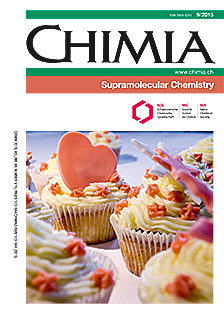Triplet–Triplet Energy Transfer Study in Hydrogen Bonding Systems
DOI:
https://doi.org/10.2533/chimia.2015.524Keywords:
Bodipy, Hydrogen bond, Intermolecular/intramolecular ttet, SupramolecularAbstract
The 2,6-diiodoBodipy–styrylBodipy hydrogen bonding system was prepared to study the effect of hydrogen bonding on the triplet–triplet-energy-transfer (TTET) process. 2,6-DiiodoBodipy linked with N-acetyl-2,6-diaminopyridine (D-2) was used as the triplet energy donor, and the styrylBodipy connected with thymine (A-1) was used as triplet energy acceptor, thus the TTET process was established upon photoexcitation. The photophysical processes of the hydrogen bonding system were studied with steady-state UV-vis absorption spectroscopy, fluorescence spectroscopy, fluorescence lifetime measurement and nanosecond time-resolved transient absorption spectroscopies. The TTET of the intramolecular/hydrogen bonding/intermolecular systems were compared through nanosecond transient absorption spectroscopy. The TTET process of the hydrogen bonding system is faster and more efficient (kTTET = 6.9 × 104 s–1, ?TTET = 94.0%) than intermolecular triplet energy transfer (kTTET = 6.0 × 104 s–1, ?TTET = 90.9%), but slower and less efficient than intramolecular triplet energy transfer (kTTET > 108 s–1). These results are valuable for designing self-assembly triplet photosensitizers and for the study of the TTET process of hydrogen bonding systems.Downloads
Published
2015-09-30
Issue
Section
Scientific Articles
License
Copyright (c) 2015 Swiss Chemical Society

This work is licensed under a Creative Commons Attribution-NonCommercial 4.0 International License.
How to Cite
[1]
Chimia 2015, 69, 524, DOI: 10.2533/chimia.2015.524.







